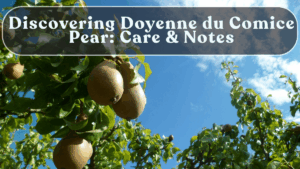The Doyenne du Comice Pear, often called the “Queen of Pears,” is celebrated worldwide for its rich aroma, creamy texture, and unparalleled sweetness. Originating from France in the 19th century, this heirloom variety remains one of the most prized dessert pears in the world. It thrives beautifully in no-dig organic orchards, making it an excellent choice for gardeners who prefer minimal soil disturbance and sustainable growing methods.
Here’s how you can successfully grow and care for the Doyenne du Comice pear in your own home garden.

About the Doyenne du Comice Variety
This pear variety is known for its round shape, greenish-yellow skin, and rosy blush on the sun-exposed side. The flesh is buttery, juicy, and sweet—perfect for eating fresh or pairing with cheese.
Doyenne du Comice pears ripen in mid-August to early September, making them one of the highlights of late summer harvests. The trees are moderately vigorous and begin fruiting within 3–4 years of planting, offering long-term yield with proper care.
Ideal Growing Conditions
Doyenne du Comice prefers a cool to mild climate and grows best in fertile, well-drained soil.
-
Temperature: Ideal range is 10°C–30°C.
-
Sunlight: At least 6 hours of direct sunlight daily.
-
Soil Type: Loamy or sandy with good moisture retention.
-
pH Level: Neutral (6.5–7.5).
Mulching around the tree with compost, leaves, or straw helps maintain moisture and supports a healthy no-dig system.
Planting and No-Dig Method
For those following the no-dig orchard method, avoid tilling the soil. Instead:
-
Place compost or organic mulch over the soil surface.
-
Cut small holes to insert saplings or bare-root plants.
-
Let earthworms and soil microbes naturally improve soil structure.
If planting traditionally, dig a 2×2 foot hole, mix in compost and garden soil, and plant the sapling so that the graft union is above ground. Space trees about 12–15 feet apart for proper canopy development.
Watering and Feeding
Water deeply every 7–10 days during the growing season. Avoid frequent shallow watering—it promotes weak roots. Mulching reduces evaporation and keeps soil cool in summer.
Feed the tree twice a year:
-
Spring: Apply compost or well-rotted manure.
-
Summer: Add potassium-rich fertilizer (like banana peel compost) to support fruit formation and sweetness.
Avoid excessive nitrogen, which encourages leafy growth at the expense of fruits.
Pruning and Pollination
Pruning is essential for airflow and sunlight penetration. Prune the tree in late winter to remove dead or crossing branches and shape an open canopy.
While Doyenne du Comice is partially self-fertile, it bears better when cross-pollinated with compatible varieties like Conference or Williams’ Bon Chrétien pears. Bees play a crucial role in natural pollination, so avoid chemical sprays during flowering.
Pest and Disease Management
Common pear issues include aphids, pear scab, and leaf spot. To manage them naturally:
-
Spray neem oil or soap water weekly during the growing season.
-
Encourage beneficial insects like ladybugs.
-
Keep the orchard clean and remove fallen leaves to reduce fungal spread.
The no-dig system naturally improves soil health and resilience against many diseases by maintaining microbial balance.
Harvesting and Storage
Harvest pears when they are firm but slightly yellowing, usually in mid to late August. Unlike some fruits, pears ripen off the tree—store them in a cool, dry place for 5–7 days until soft and aromatic.
Refrigerate ripe pears to extend freshness for up to two weeks. Doyenne du Comice pears are best enjoyed fresh, but also make excellent preserves and desserts.
Conclusion
The Doyenne du Comice Pear is a timeless classic for gardeners who appreciate flavor and elegance. By using no-dig, organic methods, you can enjoy sustainable, low-maintenance fruit production while preserving soil health. With its buttery texture and sweet fragrance, this pear brings gourmet quality right to your backyard orchard.
FAQs
When does Doyenne du Comice pear ripen?
It typically ripens between mid-August and early September, depending on the climate.
Is Doyenne du Comice self-pollinating?
It’s partially self-fertile but produces better yield with a pollinator variety nearby.
Can I grow it in pots?
Yes, use a large 20–24 inch pot with rich, well-drained soil and full sunlight.
How often should I water the tree?
Water deeply once every 7–10 days, adjusting frequency based on temperature.
What makes this pear special?
Its exceptional sweetness, buttery texture, and fragrance make it one of the finest dessert pears ever cultivated.
